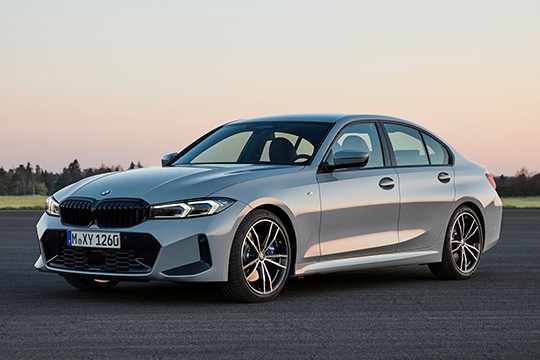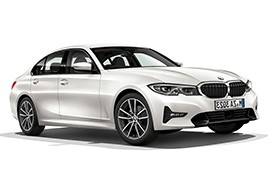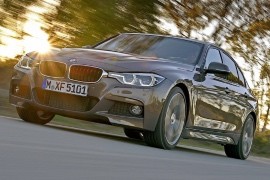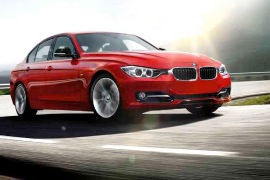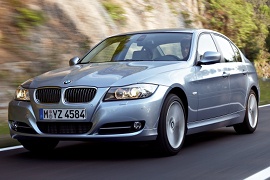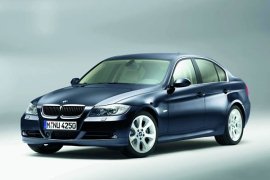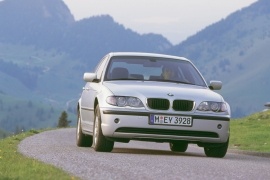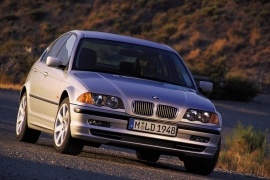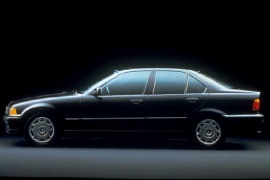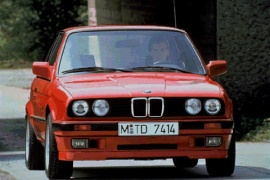BMW 3 Series Sedan Models/Series Timeline, Specifications & Photos
First production year: 1982
Engines: Mild hybrid diesel, Gasoline, Hybrid gasoline, Mild hybrid, Diesel, Hybrid
After a little over three years on the market, the seventh generation of the BMW 3 Series received an update, or LCI (Life Cycle Impulse), as the carmaker named it.
The 3 Series was the most successful model in BMW's history, selling over 16 million of them between 1975 and 2021 in seven generations. Moreover, between October 2018, when the seventh generation was introduced at the Paris Motor Show, and May 2022, when the car received an LCI, it was sold in over 1 million units, making it the best selling generation compared to its predecessors. Still, the German carmaker decided to keep the sales figures up and refreshed the range.
With its refreshed front fascia, the 3 Series sedan looked even sportier thanks to the reshaped headlights and the enlarged "kidney-grille" at the front. Moreover, as an option, the carmaker added adaptive LED headlamps. Last but not least, the aggressive design could have been enhanced even more with the optional M Sport Package and M Sport Package Pro, the latter being available for the first time in the 3 Series.
The interior went through a significant upgrade with the introduction of the BMW Curved Display, which featured the 12.3" instrument panel in front of the driver and the 14.9" infotainment screen atop the center stack. Both panels were covered by the same piece of glass, creating a flowing sensation as a unique wide display.
Under the hood, BMW installed a wide choice of engines, ranging between 148 hp (150 PS) and 369 hp (374 PS), with either four or six cylinders fed by gasoline or diesel. Moreover, a plug-in hybrid version was also available. Depending on the engine version and options, the power went to the rear or in all corners via a manual or an automatic transmission.
The German automaker BMW introduced the seventh generation of the 3 Series in 2018, continuing its streak of successful models in the compact executive sedan segment.
BMW produced over 15 million units of the 3 Series since the model's launch in 1975, and it was the money-maker of the family. As a result, the carmaker had to meet its customers' high expectations for the G20, and they did it. It was a completely new vehicle that carried over just a few elements from its predecessor, the E90, and more from its bigger sibling, the 5 Series (G30), with which it shared its CLAR platform.
With a design that followed the idea of its predecessor, the 3 Series G20 featured narrow headlights and a slightly larger kidney grille. Besides the base models that featured bi-xenon headlights, the automaker offered a full-LED package with high-beam assist. Depending on the options and packages, the 2018 3 Series featured an elegant bumper with slim and horizontal air intake flanked by small scoops. Those who opted for the sports package got the car with a more aggressive stance featuring triangular-shaped air intakes that cooled the front brakes. From its profile, the long hood was followed by the greenhouse, which was extended towards the back of the vehicle in a cab-rearward design. Thanks to its short deck at the back, the 3 Series G20 offered a sporty look for its customers. The taillights were full-LEDs and were extended from the quarter panels to the trunk lid, thus improving the car's visibility from the rear. Under the bumper, the carmaker installed either one or two exhausts, depending on the engine version and options.
Inside, the automaker offered options for either a digital or an analog instrument cluster complemented by a touchscreen for the infotainment system placed atop the center stack in a free-floating position. On the center tunnel that separated the front occupants, BMW installed the gear stick or the selector for the automatic transmission, several buttons for driving modes (ECO, comfort, sport), parking sensors, and an electric handbrake. In addition, the iDrive infotainment's system rotary dial was also housed there. Customers had the option to buy the car with either bucket seats or high-bolstered ones that provided better support during high-speed cornering. There was plenty of legroom for two passengers in the back on the split-folding bench seat, although the tall transmission tunnel limited comfort for a middle-seated one.
Under the hood, there was a wide range of diesel and gasoline powerplants mated with either a six-speed manual or an eight-speed automatic. Like in the previous generation, most versions could've been bought with either a rear- or an all-wheel-drive system. In addition, a plug-in hybrid system was on offer.
BMW 3 Series Sedan (G20) 318d 6MT (150 HP)
BMW 3 Series Sedan (G20) 318d 8AT (150 HP)
BMW 3 Series Sedan (G20) 320d 6MT (190 HP)
BMW 3 Series Sedan (G20) 320d 8AT (190 HP)
BMW 3 Series Sedan (G20) 320d 8AT (265 HP)
BMW 3 Series Sedan (G20) 320d xDrive 8AT AWD (190 HP)
The German automaker introduced the refreshed version of the 3 Series' fifth generation in 2016, adding subtle exterior changes but, more important technological upgrades.
When BMW introduced the fifth generation of its 3 Series in 2012, and it had to improve it in just a few years to comply with Euro 6 emission standards. While it silently did some of the upgrades in 2014, the facelifted version broke covers in 2016. And, as usual, the German automaker didn't call its refreshed models "facelifted" but as LCIs or Life-Cycle Impulse.
The car's exterior boasted a redesigned front fascia that incorporated the radar for the Adaptive Cruise Control and AEBS system behind the lower grille when fitted with that. In addition, depending on the trim level and options, it featured larger or smaller side scoops, the latter being used for the M-Package version.
The interior boasted a new center console that featured a sliding cover for a pair of cup holders, which was mostly used to store mobile phones, though. Inside the instrument cluster, BMW installed a four-dial panel with a clean design and a small display at its bottom for the onboard computer.
BMW had to upgrade its entire engine lineup to comply with stricter Euro 6 emission standards. That led to a completely turbocharged engine lineup, regardless if they were fueled by gasoline or diesel. Moreover, another significant addition to the range was the 330e version, which was a plug-in hybrid.
BMW 3 Series Sedan (F30) LCI 316d 6MT (116 HP)
BMW 3 Series Sedan (F30) LCI 316d 8AT (116 HP)
BMW 3 Series Sedan (F30) LCI 318 xDrive 6MT (150 HP)
BMW 3 Series Sedan (F30) LCI 318d 6MT (150 HP)
BMW 3 Series Sedan (F30) LCI 318d 8AT (150 HP)
BMW 3 Series Sedan (F30) LCI 320d 6MT (190 HP)
BMW 3 Series Sedan (F30) LCI 320d 8AT (190 HP)
BMW 3 Series Sedan (F30) LCI 320d EfficientDynamics 6MT (163 HP)
BMW 3 Series Sedan (F30) LCI 320d EfficientDynamics 8AT (163 HP)
BMW 3 Series Sedan (F30) LCI 320d xDrive 8AT (190 HP)
BMW 3 Series Sedan (F30) LCI 325d 6MT (218 HP)
BMW 3 Series Sedan (F30) LCI 325d 8AT (218 HP)
BMW 3 Series Sedan (F30) LCI 330d 8AT (258 HP)
BMW 3 Series Sedan (F30) LCI 330d xDrive 8AT (258 HP)
BMW 3 Series Sedan (F30) LCI 318i 6MT (136 HP)
BMW 3 Series Sedan (F30) LCI 318i 8AT (136 HP)
BMW 3 Series Sedan (F30) LCI 320i 6MT (184 HP)
BMW 3 Series Sedan (F30) LCI 320i 8AT (184 HP)
BMW 3 Series Sedan (F30) LCI 320i xDrive 6MT (184 HP)
BMW 3 Series Sedan (F30) LCI 320i xDrive 8AT (184 HP)
BMW 3 Series Sedan (F30) LCI 330i 6MT (252 HP)
BMW 3 Series Sedan (F30) LCI 330i 8AT (252 HP)
BMW 3 Series Sedan (F30) LCI 330i xDrive 8AT (252 HP)
BMW 3 Series Sedan (F30) LCI 340i 6MT (326 HP)
BMW 3 Series Sedan (F30) LCI 340i 8AT (326 HP)
The sixth generation of the 3 Series broke cover in late 2011 as a 2012 model year, and, like its predecessors, it relied on a sporty driving experience and premium quality to convince its buyers.
BMW’s best-selling model, the 3 Series, was on the market since 1975, and while the first generation was available only as a two-door coupe, it evolved into a full range of products. In 2012, the 3 Series lost its coupe version, which became the 4 Series, but the four-door sedan remained one of the best vehicles made by the German automaker. The new generation came with a wider range of engines than its predecessor, offering not just diesel and gasoline powerplants but also a hybrid version, representing the start of the electrification era for this nameplate.
The sixth generation of this nameplate got the F30 internal designation and was the first 3 Series to ditch the E-XX coding system used for decades by BMW. The design and technology installed on this car were a leap forward compared to its predecessor, the E90. At the front, the automaker installed a pair of headlights that looked pinched on their inner side, towards the grille. The standard version of the car featured a lower bumper with a broad grille, with an option for round fog lamps. In addition, an M-package came with a different look, with broad air intakes that flanked a V-shaped lower grille. From its profile, the cab-rearward design was emphasized by the long hood and short rear deck. Furthermore, the crease along the bodywork started from the front fenders, ran along the door panels towards the rear quarter panels, and ended on the taillights. Depending on the engine version and options, the F30 featured single, double, or dual exhausts with one pipe on each side.
Inside, the cockpit was dominated by high-quality materials, even in the lowest grade, which was fitted with cloth seats. Still, customers could get sports bucket seats with high bolstered areas. Fronting the driver was a clean-designed instrument cluster with large dials for the speedometer and tachometer. BMW installed a screen for the iDrive infotainment system atop the center stack, above the center vents. Despite the long wheelbase of the vehicle, in the back, there was not too much legroom for adult-sized passengers due to the longitudinally mounted engine at the front and the tall transmission tunnel.
Under the hood, the automaker installed a wide choice of engines with three, four, and six cylinders, all turbocharged, both gasoline and diesel. Standard transmission for most of the range consisted of a six-speed manual, while an eight-speed automatic was available at extra cost. BMW offered the 3 Series with either rear or all-wheel-drive transmissions, depending on the options.
BMW 3 Series (F30) 316d 6MT RWD (116 HP)
BMW 3 Series (F30) 316d 8AT RWD (116 HP)
BMW 3 Series (F30) 318 xDrive 6MT AWD (143 HP)
BMW 3 Series (F30) 318d 6MT RWD (143 HP)
BMW 3 Series (F30) 318d 8AT RWD (143 HP)
BMW 3 Series (F30) 320d 6MT RWD (184 HP)
BMW 3 Series (F30) 320d 8AT RWD (184 HP)
BMW 3 Series (F30) 320d Efficient Dynamics 6MT RWD (163 HP)
BMW 3 Series (F30) 320d Efficient Dynamics 8AT RWD (163 HP)
BMW 3 Series (F30) 320d xDrive 6MT AWD (184 HP)
BMW 3 Series (F30) 320d xDrive 8AT AWD (184 HP)
BMW 3 Series (F30) 325d 6MT RWD (218 HP)
BMW 3 Series (F30) 328d 8AT RWD (184 HP)
BMW 3 Series (F30) 328d xDrive 8AT AWD (184 HP)
BMW 3 Series (F30) 330d 8AT RWD (258 HP)
BMW 3 Series (F30) 316i 6MT RWD (136 HP)
BMW 3 Series (F30) 316i 8AT RWD (136 HP)
BMW 3 Series (F30) 320i 6MT RWD (184 HP)
BMW 3 Series (F30) 320i 8AT RWD (184 HP)
BMW 3 Series (F30) 320i Efficient Dynamics Edition 6MT RWD (170 HP)
BMW 3 Series (F30) 320i Efficient Dynamics Edition 8AT RWD (170 HP)
BMW 3 Series (F30) 320i xDrive 6MT AWD (184 HP)
BMW 3 Series (F30) 320i xDrive 8AT AWD (184 HP)
BMW 3 Series (F30) 328i 6MT RWD (245 HP)
BMW 3 Series (F30) 328i 8AT RWD (245 HP)
BMW 3 Series (F30) 328i xDrive 6MT AWD (245 HP)
BMW 3 Series (F30) 328i xDrive 8AT AWD (245 HP)
BMW 3 Series (F30) 335i 6MT RWD (306 HP)
BMW 3 Series (F30) 335i 8AT RWD (306 HP)
BMW upgraded the 3-Series lineup in 2008 and made it ready for the Euro 5 norms that became mandatory starting with January 2009.
After four years on the market and a successful career, the German carmaker had to improve its engine lineup. As usual, it couldn't refresh only the drivetrains, and it had to work on other areas as well.
At the front, the main difference was seen in the company's "kidney" grille design, which featured rounded interior edges instead of the clear-cut style used before. BMW also included the grille's chromed top rim in the front fascia, not on the hood as it was on the pre-facelifted version. The lower bumper area received a smiling cut instead of the straight one. Further modifications followed in the rear, where the new LED taillights featured smaller reversing lights.
Inside, the most visible change was for the automatic transmission selector. On the 2008 model, BMW adopted the joy-stick system used on the bigger brother 5-Series instead of the classic, linear style with a side gate for the manual mode. The optional iDrive system featured voice-controls and a set of buttons used for short-cuts to the menu.
Under the hood, the German carmaker offered a vast engine choice and started it with a 2.0-liter naturally aspirated gasoline unit that provided 136 hp, seven more than its predecessor. For turbo-diesel versions, BMW introduced a fuel-efficient 115 hp unit paired with a 6-speed manual. The all-wheel-drive versions were named as xDrive instead of xD or xI as before.
BMW 3 Series (E90) 316d 6MT (115 HP)
BMW 3 Series (E90) 318d 6AT (143 HP)
BMW 3 Series (E90) 318d 6MT (143 HP)
BMW 3 Series (E90) 320d 6AT (177 HP)
BMW 3 Series (E90) 320d 6AT (184 HP)
BMW 3 Series (E90) 320d 6MT (177 HP)
BMW 3 Series (E90) 320d 6MT (184 HP)
BMW 3 Series (E90) 320d EfficientDynamics Edition 6MT (163 HP)
BMW 3 Series (E90) 320d xDrive 6AT (177 HP)
BMW 3 Series (E90) 320d xDrive 6AT (184 HP)
BMW 3 Series (E90) 320d xDrive 6MT (177 HP)
BMW 3 Series (E90) 320d xDrive 6MT (184 HP)
BMW 3 Series (E90) 325d 6AT (197 HP)
BMW 3 Series (E90) 325d 6AT (204 HP)
BMW 3 Series (E90) 325d 6MT (197 HP)
BMW 3 Series (E90) 325d 6MT (204 HP)
BMW 3 Series (E90) 330d 6AT (245 HP)
BMW 3 Series (E90) 330d 6MT (245 HP)
BMW 3 Series (E90) 318i 6AT (136 HP)
BMW 3 Series (E90) 318i 6AT (143 HP)
BMW 3 Series (E90) 318i 6MT (136 HP)
BMW 3 Series (E90) 318i 6MT (143 HP)
BMW 3 Series (E90) 320i 6AT (170 HP)
BMW 3 Series (E90) 320i 6MT (170 HP)
BMW 3 Series (E90) 325i 6AT (218 HP)
BMW 3 Series (E90) 325i 6MT (218 HP)
BMW 3 Series (E90) 325i xDrive 6AT (218 HP)
BMW 3 Series (E90) 325i xDrive 6MT (218 HP)
BMW 3 Series (E90) 330i 6AT (272 HP)
BMW 3 Series (E90) 330i 6MT (272 HP)
BMW 3 Series (E90) 330i xDrive 6AT (272 HP)
BMW 3 Series (E90) 330i xDrive 6MT (272 HP)
BMW 3 Series (E90) 335i 6AT (306 HP)
BMW 3 Series (E90) 335i 6MT (306 HP)
The BMW 3 Series was the best sold model in the German’s producer history, with its production starting in 1975.The 5th generation of the BMW’s 3 series, also known as the E90, has a timeless design. The E90 was produced in four body options: sedan (E90), break (E91), coupe (E92) and cabrio (E93).
The optional features available were xenon headlamps, automatic climate control, parking sensor, power-adjustable seats, satellite navigation, glass sunroof, heated front seats, Bluetooth and USB audio input. Different packages were available as well, such as the Premium Package with leather seat, auto-dimming mirror, auto-folding exterior mirrors, BMW Assist w/Bluetooth, etc.
The Cold Weath er Package included headlight washers, heated front seats and folding rear seats with a ski bag. The Sports Package and Technology Package were also available with different features – different seats, steering wheel, sports suspension, keyless entry, electronic damping control.
The 3 series were available with run-flat tires, but these were not equipped with a spare tire. The sedan and the tourer were designed by Joji Nagashima, while the coupe and the convertible by Michael Markefka.
In September 2008, the facelift version was released and it included both design changes as well as mechanical. The front and rear bumpers were refreshed, as well as the wing mirrors, headlights, taillights, trunk lid and wider kidney grilles.
The AWD models became the “xDrive” models, the before facelift AWD labeled as “Xi”. The interior got slight improvements, the resolution of the display was increased and the “Professional navigation system” was updated.
BMW 3 Series (E90) 318d 6MT RWD (122 HP)
BMW 3 Series (E90) 318d 6MT RWD (143 HP)
BMW 3 Series (E90) 320d 6AT RWD (163 HP)
BMW 3 Series (E90) 320d 6AT RWD (177 HP)
BMW 3 Series (E90) 320d 6MT RWD (163 HP)
BMW 3 Series (E90) 320d 6MT RWD (177 HP)
BMW 3 Series (E90) 325d 6AT RWD (197 HP)
BMW 3 Series (E90) 325d 6MT RWD (197 HP)
BMW 3 Series (E90) 330d 6AT RWD (231 HP)
BMW 3 Series (E90) 330d 6MT RWD (231 HP)
BMW 3 Series (E90) 330xd 6AT RWD (231 HP)
BMW 3 Series (E90) 318i 6AT RWD (129 HP)
BMW 3 Series (E90) 318i 6AT RWD (143 HP)
BMW 3 Series (E90) 318i 6MT RWD (129 HP)
BMW 3 Series (E90) 318i 6MT RWD (143 HP)
BMW 3 Series (E90) 320i 6AT RWD (150 HP)
BMW 3 Series (E90) 320i 6AT RWD (170 HP)
BMW 3 Series (E90) 320i 6MT RWD (150 HP)
BMW 3 Series (E90) 320i 6MT RWD (170 HP)
BMW 3 Series (E90) 320si 6MT RWD (173 HP)
BMW 3 Series (E90) 323i 6MT RWD (177 HP)
BMW 3 Series (E90) 325i 6AT RWD (218 HP)
BMW 3 Series (E90) 325i 6MT RWD (218 HP)
BMW 3 Series (E90) 325xi 6AT AWD (218 HP)
BMW 3 Series (E90) 325xi 6MT AWD (218 HP)
BMW 3 Series (E90) 330i 6AT RWD (258 HP)
BMW 3 Series (E90) 330i 6AT RWD (272 HP)
BMW 3 Series (E90) 330i 6MT RWD (258 HP)
BMW 3 Series (E90) 330i 6MT RWD (272 HP)
BMW 3 Series (E90) 330xi 6AT AWD (258 HP)
BMW 3 Series (E90) 330xi 6AT AWD (272 HP)
BMW 3 Series (E90) 330xi 6MT AWD (258 HP)
BMW 3 Series (E90) 330xi 6MT AWD (272 HP)
BMW 3 Series (E90) 335i 6AT RWD (306 HP)
BMW 3 Series (E90) 335i 6MT RWD (306 HP)
The fourth generation of the BMW 3-Series came on the market in 1998 and rocketed to the top of the sales charts in the premium compact segment. In 2000, the Mercedes-Benz C-Class overtook it.
As usual, BMW knew that that was going to happen and as soon as it launched the 3-Series, it's engineers started to work on the facelifted version, which was introduced in 2002. It wasn't an easy job to do, but the results exceeded the expectations.
From the outside, there were minor changes to the bodywork. The distinctive new look of the headlights, with a double curved line on the bottom, matched the new bumper. In the back, a new set of taillights was installed. From the sides, there were little differences between the facelift and non-facelift versions.
Inside, a new steering wheel with paddle-shifters was installed for the vehicles equipped with the automated (SMG) transmission. Other than that, most of the base models remained the same, with minor changes to trims. The infotainment unit was upgraded.
The most important change was for the drivetrain, where a new engine lineup was introduced. The base model was a 1.8-liter unit, named 316i, which offered 115 hp. The most popular version was the 318i, which offered a 2.0-liter unit rated at 143 hp. It was the first 2.0-liter with four cylinders installed on a BMW since the first generation. Top of the range version was the 231 hp 3.0-liter unit, which could have been mated to a 6-speed manual, with rear or all-wheel-drive system. All versions were available with an automatic, 5-speed transmission.
BMW 3 Series (E46) 316i 5AT RWD (115 HP)
BMW 3 Series (E46) 316i 5MT RWD (115 HP)
BMW 3 Series (E46) 318i 5AT RWD (143 HP)
BMW 3 Series (E46) 318i 5MT RWD (143 HP)
BMW 3 Series (E46) 320i 5AT RWD (170 HP)
BMW 3 Series (E46) 320i 5MT RWD (170 HP)
BMW 3 Series (E46) 325i 5AT RWD (192 HP)
BMW 3 Series (E46) 325i 5MT RWD (192 HP)
BMW 3 Series (E46) 330i 5AT RWD (231 HP)
BMW 3 Series (E46) 330i 5MT RWD (231 HP)
BMW 3 Series (E46) 330i 6MT RWD (231 HP)
BMW 3 Series (E46) 330xi 5AT AWD (231 HP)
BMW 3 Series (E46) 318d 5AT RWD (115 HP)
BMW 3 Series (E46) 318d 5MT RWD (115 HP)
BMW 3 Series (E46) 320d 5AT RWD (150 HP)
BMW 3 Series (E46) 320d 5MT RWD (150 HP)
BMW 3 Series (E46) 320d 6MT RWD (150 HP)
BMW 3 Series (E46) 330d 5AT RWD (184 HP)
BMW 3 Series (E46) 330d 5AT RWD (204 HP)
BMW 3 Series (E46) 330d 5MT RWD (184 HP)
BMW 3 Series (E46) 330d 6MT RWD (204 HP)
BMW 3 Series (E46) 330xd 5AT AWD (184 HP)
BMW 3 Series (E46) 330xd 5AT AWD (204 HP)
After three generations of the 3-Series, in 1998, BMW introduced the fourth generation. It wasn't the big visual leap between the second and the third generation, but it was an important technical evolution.
The design of the new generation E46 started in 1993 just three years after the previous generation was introduced to the market. In November 1997, BMW send the press release for their new vehicle and, in April 1998, it started the sales and deliveries.
The new design featured clear headlights cover over the lamps and a downward shaped turn-signal on the corners. The hood comprised the “BMW-kidney” grille design. To cool the engine, the bigger grilles were on the lower side of the bumper, under the foglights. The flared wheel-arches were no longer reserved for top-spec models, but for the entire range of the car.
Inside, the car featured all the important information for the driver. The instrument cluster featured the five standard dials in most of the 3-Series since the introduction of the E30: coolant temperature, speedometer, tachometer, fuel level and, on the lower part of the rev-counter, the instant fuel dial. The dashboard was no longer that much tilted toward the driver so the passenger could enjoy or adjust easier the audio controls.
The technical modifications of the E46 were important. It was the first 3-Series that offered engines with more than 100 hp even on the base engine. The E46 also marked the return of the all-wheel-drive system, which was used on the E30 but lost on the E36 generation. It also saw the introduction of a new, 2.0-liter turbodiesel engine. The car was available with 5- or 6-speed manual transmission and 4- and 5-speed automatic.
BMW 3 Series (E46) 316i 4AT RWD (105 HP)
BMW 3 Series (E46) 316i 5MT RWD (105 HP)
BMW 3 Series (E46) 318i 4AT RWD (118 HP)
BMW 3 Series (E46) 318i 5MT RWD (118 HP)
BMW 3 Series (E46) 320i 5AT RWD (170 HP)
BMW 3 Series (E46) 320i 5MT RWD (150 HP)
BMW 3 Series (E46) 320i 5MT RWD (170 HP)
BMW 3 Series (E46) 323i 5AT RWD (170 HP)
BMW 3 Series (E46) 323i 5MT RWD (170 HP)
BMW 3 Series (E46) 325i 5AT RWD (192 HP)
BMW 3 Series (E46) 325i 5MT RWD (192 HP)
BMW 3 Series (E46) 328i 5AT RWD (193 HP)
BMW 3 Series (E46) 328i 5MT RWD (193 HP)
BMW 3 Series (E46) 330i 5AT RWD (231 HP)
BMW 3 Series (E46) 330i 5MT RWD (231 HP)
It was hard to replace such a success story as the BMW 3-Series E30 that moved the company on top of the heights in the compact premium-car market. But it had to be done and, in 1991, the replacement was shown.
When the second generation of the 3-Series was launched, the straight and simple lines were trendy. But that was more like the '70s design language and in the early '90s it was already considered as obsolete. New technologies were discovered and new trends followed.
The design looked like it was a scaled-down 5-Series. It was longer, wider and taller than its predecessor. With a front fascia covered by the headlights and the widened “BMW kidney” grille, the car was more aerodynamic than its predecessor. It featured a drag coefficient of 0.29, compared with the previous 3-Series that had a 0.33. The longer engine compartment allowed a much bigger space for the engines and a crumple zone. In 1993, the car received a mid-life cycle refresh that changed some of the engines and brought some others.
Inside, the legroom was better than the one offered by the E30. It now featured standard power steering and brakes for all the range. The interior featured optional amenities such as four power windows, air-conditioning or climate control, on-board computer, airbags for the driver and front passenger, sunroof, and a premium audio system.
Under the hood there was a wide range of engines starting with a 1.6-liter unit and up to a 3.2-liter for the M3. For the diesel versions, there was a 1.8-liter and a 2.5-liter unit, both turbocharged.
BMW 3 Series Sedan (E36) 316i 4AT (102 HP)
BMW 3 Series Sedan (E36) 316i 4AT (99 HP)
BMW 3 Series Sedan (E36) 316i 5MT (102 HP)
BMW 3 Series Sedan (E36) 316i 5MT (99 HP)
BMW 3 Series Sedan (E36) 318i 4AT (115 HP)
BMW 3 Series Sedan (E36) 318i 5MT (115 HP)
BMW 3 Series Sedan (E36) 318is 4AT (140 HP)
BMW 3 Series Sedan (E36) 318is 5MT (140 HP)
BMW 3 Series Sedan (E36) 320i 5AT (150 HP)
BMW 3 Series Sedan (E36) 320i 5MT (150 HP)
BMW 3 Series Sedan (E36) 323i 5AT (170 HP)
BMW 3 Series Sedan (E36) 323i 5MT (170 HP)
BMW 3 Series Sedan (E36) 325i 5AT (192 HP)
BMW 3 Series Sedan (E36) 325i 5MT (192 HP)
BMW introduced a new generation of the 3 Series in 1982. It was an important step forward compared to its predecessor, especially since it also came in the highly-demanded four-door shape.
The first generation of the 3 Series was a blast to drive for those times. It was a sports coupe vehicle that charmed close to 1.4-million customers worldwide, and it could have been even more successful if it had a four-door version. However, that problem was fixed with the introduction of the 3 Series' second generation, the famous E30.
One of the most coveted features of the first-generation 3 Series was the quad-headlights design, and the carmaker decided to make it standard on the entire range. Its black grille with horizontal slats and the kidney grille that adorned the center of the front fascia were easy to recognize. It was an advanced design for its time, with body-colored bumpers adorned by black rubber strips to protect it from small scratches. The chromed trims around the windows were specific for the pre-facelifted model, which appeared in 1987. Even though it sported a four-door bodywork, the sedan shared the same wheelbase as its coupe sibling.
Inside, the dashboard featured a driver-oriented center stack, with the HVAC controls placed under the stereo. Worth mentioning that not all versions came fitted with an AC unit. Also, not all versions featured a tachometer. BMW installed bucket seats for the front passengers and a center console that subtly divided the driving area from the rest of the car. At the back, the carmaker placed a bench for three, although the one seated in the middle had to share their legroom with the transmission tunnel.
Under the hood, BMW placed a wide engine range, sending their power to the rear wheels via a manual or an automatic transmission.
BMW 3 Series Sedan (E30) 316 4AT RWD (90 HP)
BMW 3 Series Sedan (E30) 316 5MT RWD (90 HP)
BMW 3 Series Sedan (E30) 316i 4AT RWD (102 HP)
BMW 3 Series Sedan (E30) 316i 4AT RWD (99 HP)
BMW 3 Series Sedan (E30) 316i 5MT RWD (102 HP)
BMW 3 Series Sedan (E30) 316i 5MT RWD (99 HP)
BMW 3 Series Sedan (E30) 318i 4AT RWD (105 HP)
BMW 3 Series Sedan (E30) 318i 4AT RWD (113 HP)
BMW 3 Series Sedan (E30) 318i 5MT RWD (105 HP)
BMW 3 Series Sedan (E30) 318i 5MT RWD (113 HP)
BMW 3 Series Sedan (E30) 320i 4AT RWD (125 HP)
BMW 3 Series Sedan (E30) 320i 4AT RWD (129 HP)
BMW 3 Series Sedan (E30) 320i 5MT RWD (125 HP)
BMW 3 Series Sedan (E30) 320i 5MT RWD (129 HP)
BMW 3 Series Sedan (E30) 323i 4AT RWD (150 HP)
BMW 3 Series Sedan (E30) 323i 5MT RWD (150 HP)
BMW 3 Series Sedan (E30) 325e 4AT RWD (129 HP)
BMW 3 Series Sedan (E30) 325e 5MT RWD (129 HP)
BMW 3 Series Sedan (E30) 325i 4AT RWD (170 HP)
BMW 3 Series Sedan (E30) 325i 5MT RWD (170 HP)
